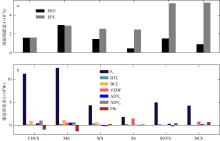热带海洋学报 ›› 2023, Vol. 42 ›› Issue (5): 1-16.doi: 10.11978/2022260CSTR: 32234.14.2022260
所属专题: 全球变化专题
• 海洋水文学 • 下一篇
斯里兰卡穹顶的演变过程及其能量学特征*
马宇1,2( ), 王卫强3,4(
), 王卫强3,4( ), 游庆龙1, 辛红雨5,6
), 游庆龙1, 辛红雨5,6
- 1. 复旦大学大气与海洋科学系, 上海 200438
2. 中国民用航空华东地区空中交通管理局, 上海 200335
3. 热带海洋环境国家重点实验室(中国科学院南海海洋研究所), 广东 广州 510301
4. 中国科学院南海生态环境工程创新研究院, 广东 广州 511458
5. 中国科学院深海科学与工程研究所, 海南 三亚 572000
6. 中国科学院大学, 北京 100049
-
收稿日期:2022-12-23修回日期:2023-04-04出版日期:2023-09-10发布日期:2023-04-17 -
作者简介:马宇(1996—), 女, 河南省驻马店市人, 硕士研究生, 从事海洋动力学研究。email: yuma20@fudan.edu.cn
-
基金资助:国家重点研发计划项目(2022YFE0203500); 国家自然科学基金项目(91958202); 中国科学院南海海洋研究所自主部署项目(SCSIO202201); 中国科学院南海生态环境工程创新研究院自主部署项目(ISEE2021ZD01)
The evolution and energy characteristics of the Sri Lanka Dome*
MA Yu1,2( ), WANG Weiqiang3,4(
), WANG Weiqiang3,4( ), YOU Qinglong1, XIN Hongyu5,6
), YOU Qinglong1, XIN Hongyu5,6
- 1. Department of Atmospheric and Oceanic Sciences, Fudan University, Shanghai 200438, China
2. East China Air Traffic Management Bureau of Civil Aviation Administration of China, Shanghai 200335, China
3. State Key Laboratory of Tropical Oceanography (South China Sea Institute of Oceanology, Chinese Academy of Sciences), Guangzhou 510301, China
4. Innovation Academy of South China Sea Ecology and Environmental Engineering, Chinese Academy of Sciences, Guangzhou 511458, China
5. Institute of Deep-sea Science and Engineering, Chinese Academic Science, Sanya 572000, China
6. University of Chinese Academy of Sciences, Beijing 100049, China
-
Received:2022-12-23Revised:2023-04-04Online:2023-09-10Published:2023-04-17 -
Supported by:National Key R&D Program of China(2022YFE0203500); National Natural Science Foundation of China(91958202); Development Fund of South China Sea Institute of Oceanology of the Chinese Academy of Sciences(SCSIO202201); Innovation Academy of South China Sea Ecology and Environmental Engineering, Chinese Academy of Sciences(ISEE2021ZD01)
摘要:
文章基于混合坐标海洋模式(hybrid coordinate ocean model, HYCOM)等多套再分析资料, 研究了气候态斯里兰卡穹顶(Sri Lanka Dome, SLD)的演变过程及其能量学特征。研究显示, SLD有两次从发展、成熟至减弱的过程, 相伴随的是其涡动能(eddy kinetic energy, EKE)也出现两次峰值。在第一次发展阶段(5月23日—6月10日), SLD在斯里兰卡的东南部开始发展, 并逐渐移向东部, 伴随着面积和强度逐渐增大。在此过程中, 风应力持续输入EKE, 海洋不稳定过程使得平均流能量转化为EKE和涡势能(eddy available potential energy, EPE), 以及西南季风流(southwest monsoon current, SMC)的平流作用, 均使得SLD迅速加强。在成熟阶段(6月11—22日), SLD位于斯里兰卡东部, 风应力做功和涡流相互作用的增强使得SLD区域内的EKE和EPE达到第一个峰值。在减弱阶段(6月23日—7月20日), SLD向西北移动, 由于平流项引起EKE和EPE的耗散, 加上风应力做功和斜压不稳定显著减小, 使得SLD区域的EKE和EPE衰减, 强度显著减小。而在稳定阶段(7月21日—8月14日), SLD移至斯里兰卡东北部, 风应力做功, 压强做功和涡流相互作用较弱, 使得SLD的强度始终维持一个较弱的水平。在第二次发展阶段(8月15—25日), SLD北移, 伴随着风应力做功和压强做功的增强, 其强度增大。在消亡阶段(8月26日—9月5日), 海洋不稳定过程使得EKE和EPE转化为平均流能量, 导致SLD逐渐消亡。因此, 风应力做功、涡流相互作用、压强做功以及源自SMC的平流作用是控制SLD演变的主要因子。
引用本文
马宇, 王卫强, 游庆龙, 辛红雨. 斯里兰卡穹顶的演变过程及其能量学特征*[J]. 热带海洋学报, 2023, 42(5): 1-16.
MA Yu, WANG Weiqiang, YOU Qinglong, XIN Hongyu. The evolution and energy characteristics of the Sri Lanka Dome*[J]. Journal of Tropical Oceanography, 2023, 42(5): 1-16.

图3
能量转化示意图(仅展示与EKE和EPE相关的能量转换项) MKE为平均流动能; MPE为平均可用势能; EKE为涡动能; EPE为涡势能; BTC (BTC1+BTC2)为正压转换项; BCC (BCC1+BCC2)为斜压MPE→EPE转换项; VEDF为斜压EPE→EKE转换项; $\text{AD}{{\text{V}}_{\text{k}}}$ 为EKE平流项; PW为压强做功项; ${{\text{F}}_{\text{k}}}$为风应力做功项; ${{\text{D}}_{\text{k}}}$为EKE耗散项; $\text{AD}{{\text{V}}_{\text{p}}}$为EPE平流项; ${{\text{F}}_{\text{p}}}$和${{\text{D}}_{\text{p}}}$表示热通量、淡水通量以及垂直混合等对EPE的贡献"


图13
SLD区域上层200m体积积分的涡旋场能量(a)和能量转化项(b)在SLD的第一次发展阶段(FDVS)、成熟阶段(MS)、减弱阶段(WS)、稳定阶段(SS)和第二次发展阶段(SDVS)、消亡阶段(DCS)的对比 EKE为涡动能; EPE为涡势能; ${{\text{F}}_{\text{k}}}$为风应力做功项; BTC为正压转换项; BCC为斜压MPE→EPE转换项; VEDF为斜压EPE→EKE转换项; $\text{AD}{{\text{V}}_{\text{k}}}$为EKE平流项; $\text{AD}{{\text{V}}_{\text{p}}}$为EPE平流项; PW为压强做功项"

| [1] |
杜岩, 张涟漪, 张玉红, 2019. 印度洋热带环流圈热盐输运及其对区域气候模态的影响[J]. 地球科学进展, 34(3): 243-254.
doi: 10.11867/j.issn.1001-8166.2019.03.0243 |
|
doi: 10.11867/j.issn.1001-8166.2019.03.0243 |
|
| [2] |
EKANAYAKA K B S S J, 王卫强, 2019. 斯里兰卡穹顶区的形成和演变机制分析[J]. 南京信息工程大学学报, 11(2): 198-207.
|
|
|
|
| [3] |
何蔚邦, 杨洋, 梁湘三, 2022. 斯里兰卡以东海域涡旋偶极子的生成与维持机制[J]. 海洋科学进展, 40(3): 379-398.
|
|
|
|
| [4] |
季页, 杨洋, 梁湘三, 2022. 孟加拉湾海域背景流-中尺度涡-高频扰动之间的相互作用[J]. 海洋学报, 44(9): 23-37.
|
|
|
|
| [5] |
乐洲, 黄科, MANTRAVADI V S, 2020. 2000—2015年夏秋季孟加拉湾湾口区涡流相互作用能量学特征[J]. 热带海洋学报, 39(2): 11-24.
doi: 10.11978/2019047 |
|
|
|
| [6] |
邱云, 李立, 周喜武, 2008. 斯里兰卡冷涡及其成因分析[J]. 热带海洋学报, 27(4): 45-51.
|
|
|
|
| [7] |
田永青, 邱云, 林新宇, 2022. 阿拉伯海高盐水入侵孟加拉湾的季节形态及动力机制[J]. 应用海洋学学报, 41(1): 100-108.
|
|
|
|
| [8] |
doi: 10.1002/jgrc.v122.9 |
| [9] |
doi: 10.1029/2018JG004446 |
| [10] |
doi: 10.1016/j.pocean.2011.01.002 |
| [11] |
doi: 10.1016/j.csr.2012.07.011 |
| [12] |
doi: 10.1002/jgrc.v123.3 |
| [13] |
doi: 10.1175/JPO-D-14-0009.1 |
| [14] |
doi: 10.1175/JPO-D-16-0012.1 |
| [15] |
doi: 10.1002/jgrc.20075 |
| [16] |
|
| [17] |
doi: 10.5194/bg-11-5909-2014 |
| [18] |
doi: 10.1038/sdata.2015.28 |
| [19] |
doi: 10.1007/s10872-017-0435-z |
| [20] |
doi: 10.1029/2021JC017459 |
| [21] |
doi: 10.5670/oceanog |
| [22] |
doi: 10.3390/rs14143239 |
| [23] |
doi: 10.1175/JTECH-D-14-00019.1 |
| [24] |
|
| [25] |
|
| [26] |
|
| [27] |
doi: 10.1080/01431161.2020.1727057 |
| [28] |
doi: 10.1029/2004GL020247 |
| [29] |
doi: 10.1175/JPO-D-14-0071.1 |
| [30] |
doi: 10.1007/s10236-019-01295-x |
| [31] |
doi: 10.1016/S0079-6611(01)00083-0 |
| [32] |
doi: 10.1029/2006GL027573 |
| [33] |
doi: 10.1016/S0079-6611(02)00024-1 |
| [34] |
doi: 10.1175/1520-0485(1990)020<1742:TMACIG>2.0.CO;2 |
| [35] |
|
| [36] |
doi: 10.1002/grl.50274 |
| [37] |
doi: 10.1175/1520-0485(1998)028<1946:MROTSA>2.0.CO;2 |
| [38] |
doi: 10.1175/JPO-D-17-0215.1 |
| [39] |
doi: 10.1175/JPO-D-16-0113.1 |
| [40] |
doi: 10.1175/JPO-D-18-0201.1 |
| [41] |
doi: 10.1175/JPO-D-21-0198.1 |
| [42] |
doi: 10.1002/jgrc.v118.9 |
| [43] |
doi: 10.1175/JPO-D-18-0058.1 |
| [44] |
|
| [1] | 赵杰, 林延奖, 刘燃, 杜榕. 基于PredRNN++模型对南海中尺度涡旋的预测研究[J]. 热带海洋学报, 2024, 43(1): 16-27. |
| [2] | 张智晟, 谢玲玲, 李君益, 李强. 边缘海与开阔海中尺度涡生命周期演化规律对比分析: 以南海和黑潮延伸体为例[J]. 热带海洋学报, 2023, 42(4): 63-76. |
| [3] | 杨一凯, 曾丽丽. 挟带黑潮高盐水的中尺度涡在南海北部的时空特征[J]. 热带海洋学报, 2023, 42(3): 75-85. |
| [4] | 刘爽, 经志友, 詹海刚. 基于生成对抗网络模型的热带和亚热带海洋中尺度涡预报研究[J]. 热带海洋学报, 2022, 41(5): 1-16. |
| [5] | 张旭, 经志友, 郑瑞玺, 黄小龙, 曹海锦. 黑潮延伸体海域典型涡旋的次中尺度特征分析*[J]. 热带海洋学报, 2021, 40(6): 31-40. |
| [6] | 乐洲, 黄科, Venkata Subrahmanyam Mantravadi. 2000—2015年夏秋季孟加拉湾湾口区涡流相互作用能量学特征[J]. 热带海洋学报, 2020, 39(2): 11-14. |
| [7] | 王霞,方文东,陈荣裕. 南海北部海面高度的季节内变异及其传播特征 *[J]. 热带海洋学报, 2019, 38(3): 1-12. |
| [8] | 胡水波, 曹文熙, 王桂芬, 许占堂. 利用MODIS跟踪监测一个冷涡对海洋表层生物光学参数的影响*[J]. 热带海洋学报, 2016, 35(3): 1-10. |
| [9] | 田永青, 黄洪辉, 巩秀玉, 余少梅. 2014年春季南海中沙群岛北部海域的低温高盐水及其形成机制*[J]. 热带海洋学报, 2016, 35(2): 1-9. |
| [10] | 程国胜, 孙佳东, 俎婷婷, 陈举, 王东晓. 2011年夏季南海北部海区水团分析*[J]. 热带海洋学报, 2014, 33(3): 10-16. |
| [11] | 耿伍,何伟宏,邹晓理,谢强. 理想台风驱动的涡旋对吕宋海峡黑潮影响的数值研究*[J]. 热带海洋学报, 2013, 32(2): 66-73. |
| [12] | 徐驰,陈桂英,尚晓东,黄瑞新. 海洋中尺度涡旋源汇空间分布特征研究[J]. 热带海洋学报, 2013, 32(2): 37-46. |
| [13] | 尚晓东,徐驰,,陈桂英,练树民. 海洋中尺度涡的机械能及其源汇研究*[J]. 热带海洋学报, 2013, 32(2): 24-36. |
| [14] | 刘广平,胡建宇. 热带气旋过境期间黑潮流轴变化的初步分析 [J]. 热带海洋学报, 2012, 31(1): 35-41. |
|
||























